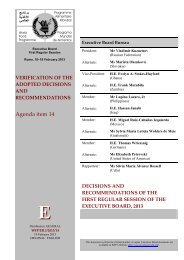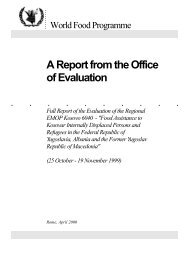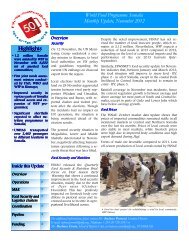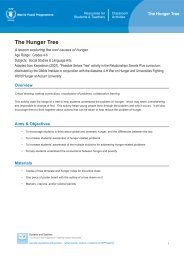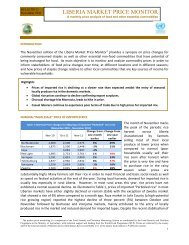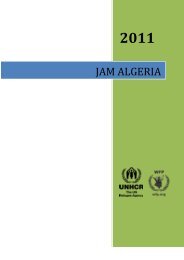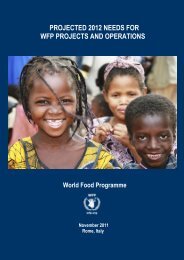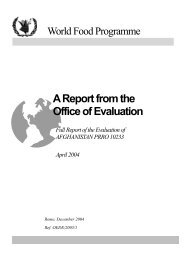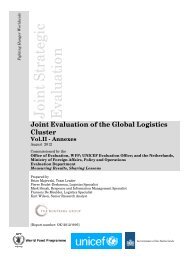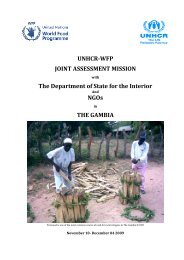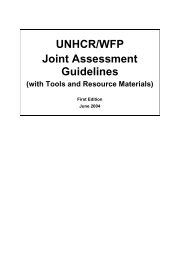The Potential for Scale and Sustainability in Weather Index Insurance
The Potential for Scale and Sustainability in Weather Index Insurance
The Potential for Scale and Sustainability in Weather Index Insurance
Create successful ePaper yourself
Turn your PDF publications into a flip-book with our unique Google optimized e-Paper software.
26<br />
CHAPTER 2<br />
WEATHER INDEX-BASED INSURANCE<br />
achieved sufficient <strong>in</strong>come growth to af<strong>for</strong>d the premiums. Of course, subsidies on a<br />
longer-term basis can create perverse <strong>in</strong>centive problems. Nevertheless, their use may<br />
still be a more cost-effective <strong>and</strong> less distort<strong>in</strong>g approach than some types of safety<br />
net programmes.<br />
Another important question is whether to <strong>in</strong>sure development providers or to<br />
<strong>in</strong>sure farmers directly. Each strategy has potential benefits <strong>and</strong> pitfalls.<br />
<strong>The</strong>re is cont<strong>in</strong>u<strong>in</strong>g debate as to whether f<strong>in</strong>ancial service providers (or other actors<br />
<strong>in</strong> the supply cha<strong>in</strong>) would be <strong>in</strong>terested <strong>in</strong> us<strong>in</strong>g <strong>in</strong>dex <strong>in</strong>surance to cover their own<br />
lend<strong>in</strong>g portfolios aga<strong>in</strong>st low-frequency, highly covariate events. In pr<strong>in</strong>ciple, such<br />
policies would protect their capital aga<strong>in</strong>st widespread defaults dur<strong>in</strong>g major<br />
catastrophes. But these policies would not help their household-level borrowers cope<br />
with risk, nor would they help repair providers’ relationships with clients after the<br />
clients have defaulted. <strong>The</strong> provider would still have the bad loans on its records, <strong>and</strong><br />
it would be very reluctant to lend to these borrowers aga<strong>in</strong>. As a result, f<strong>in</strong>ancial service<br />
providers may prefer that their borrowers use the <strong>in</strong>dex <strong>in</strong>surance as part of their<br />
household risk-management strategy <strong>and</strong> thus deal directly with the risk where it<br />
occurs. In this case, the ultimate responsibility <strong>for</strong> repay<strong>in</strong>g the loan rema<strong>in</strong>s with the<br />
<strong>in</strong>dividual borrower, while <strong>in</strong> times of distress, the payouts from the <strong>in</strong>dex <strong>in</strong>surance<br />
would repay the debt <strong>and</strong> prevent the eventual reschedul<strong>in</strong>g of or default on the loan.<br />
That said, the retail<strong>in</strong>g of products such as <strong>in</strong>dex <strong>in</strong>surance directly to <strong>in</strong>dividuals<br />
is the most difficult, time-consum<strong>in</strong>g <strong>and</strong> costly approach, particularly <strong>in</strong> develop<strong>in</strong>g<br />
economies with limited access to f<strong>in</strong>ancial services. <strong>The</strong> use of aggregators<br />
(e.g. agricultural processors, <strong>in</strong>put suppliers, f<strong>in</strong>ancial service providers, farmers’<br />
associations) is key to reduc<strong>in</strong>g these transaction costs, reach<strong>in</strong>g more clients, <strong>and</strong><br />
eventually br<strong>in</strong>g<strong>in</strong>g the reach of the products to a mean<strong>in</strong>gful scale. To achieve this,<br />
<strong>in</strong>dex <strong>in</strong>surance products could be designed to cover the portfolios of aggregators as<br />
well as the household-level risk of <strong>in</strong>dividual farmers. Under this strategy, the<br />
aggregators that are still fac<strong>in</strong>g major systemic risks could mitigate part of the risk with<br />
an <strong>in</strong>dex <strong>in</strong>surance policy, while a longer-term ef<strong>for</strong>t reaches out to cover <strong>in</strong>dividual<br />
households with <strong>in</strong>dex <strong>in</strong>surance as part of a wider development <strong>and</strong> disaster<br />
management approach.<br />
Challenges <strong>for</strong> <strong>in</strong>dex <strong>in</strong>surance<br />
Dem<strong>and</strong><br />
Relief agencies would provide the dem<strong>and</strong> <strong>for</strong> disaster-relief <strong>in</strong>dex <strong>in</strong>surance. While<br />
the number of contracts written may be few, their size could be large enough to<br />
constitute a market <strong>and</strong> attract bids from <strong>in</strong>ternational <strong>in</strong>surers. <strong>The</strong>re are many areas<br />
<strong>in</strong> which humanitarian crises are sparked by major weather shocks, <strong>and</strong> where public<br />
<strong>and</strong> NGO relief agencies could usefully be <strong>in</strong>sured with an <strong>in</strong>dex product. An<br />
important constra<strong>in</strong>t, however, would likely be the hesitation of governments to use<br />
public funds to pay <strong>in</strong>surance premiums that <strong>in</strong> most years do not generate a visible



